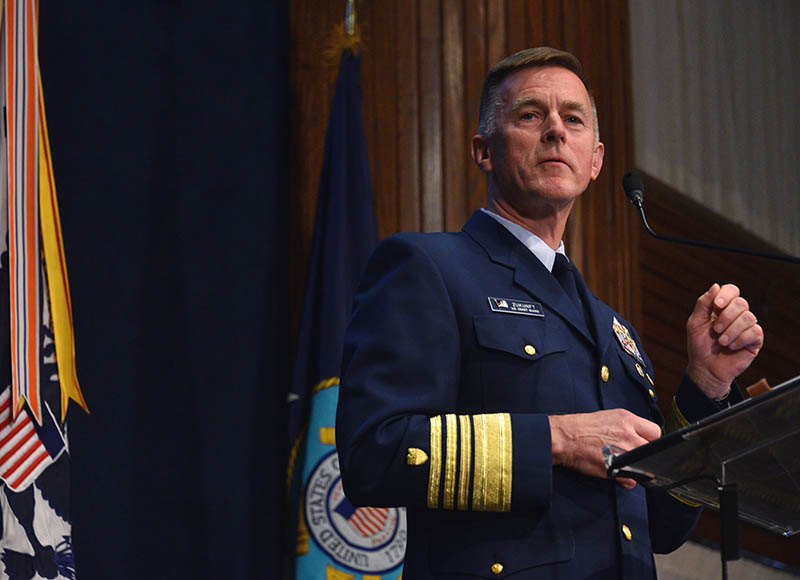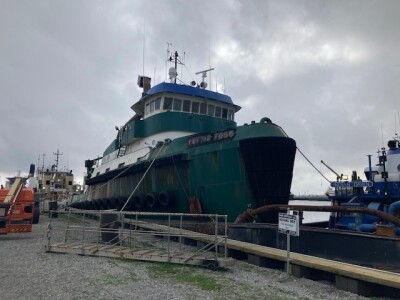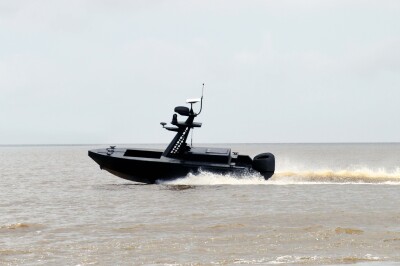The Coast Guard’s newest National Security Cutters are proving they are well worth their price tag, Commandant Adm. Paul Zukunft declared in a spirited defense of rebuilding the fleet during his annual State of the Coast Guard speech Thursday.
In his address at the National Press Club in Washington, D.C., Zukunft called for much more robust funding for the Coast Guard — on a day when the White House seemed to be feeling the hostility from Congress over reports of a possible $1.3 billion budget cut, and elimination of the ninth National Security Cutter.
“We advance maritime commerce and economic security,” Zukunft said — an argument raised by both Republic and Democratic lawmakers in recent days against potential cuts.
“We have always prided ourselves as a service that punches above our weight class…we are a service that is funded in the flyweight class,” Zukunft said. “Our funding needs to reflect the power of our punch…we need a middleweight budget.”
The 418’x54’22.5" Legend-class NSC cutters are multipliers of that power, working with other federal agencies and international partners in drug interdiction, Zukunft said.

Coast Guard cutter Stratton, the third in the National Security Cutter class, during sea trials. USCG photo.
On its first patrol, the fourth ship in the series, the Hamilton, intercepted 26 metric tons of cocaine — showing the ship “more than pays for itself in less than 100 days,” Zukunft said. The newest NSC, the James, is on track to replicate that in its first patrol, he added.
Last year cutters and aircraft working together picked up 201 metric tons of cocaine, “which used to be the annual consumption here in the United States,” Zukunft said. That trafficking is picking up in volume as South American growers and criminal networks increase output and street demand increases in the U.S., he said.
Despite the success, there were 580 known cases last year where ships and aircraft could not get to the shipments in time, Zukunft said: “It was not an issue of intelligence; it was a question of resources.”
That shows the need for a ninth NSC, and the overall recapitalization of the fleet, now on a scale not seen since the first Treasury Secretary Alexander Hamilton built the original 10 cutters of the Revenue Service, Zukunft said.
“This isn’t just about cocaine, this is about regional stability,” with drug trafficking and associated violence driving migration to the U.S., he said.
While the Coast Guard is finally embarked on developing a new icebreaker fleet, its next need is the cutter and tender fleet on the inland and coastal waterways, where 35 vessels in the fleet have a median age around 50 years, Zukunft said. With their obsolete design and burdens of lead and asbestos abatement needs, they are seen as a “geriatric class of cutters,” he said.
In personnel, the Coast Guard should be able to bring on an additional 5,000 active duty personnel, and restore 1,100 reserve billets lost to previous sequestration budget cuts, Zukunft said.
A few hours before Zukunft’s speech, White House budget director Mick Mulvaney denied earlier reports that the Office of Management and Budget had readied a 14% cut to the Coast Guard budget, including slashing $500 million from the shipbuilding program. Zukunft himself pointed out the service has already funded materials purchases for Huntington Ingalls Shipbuilding, Pascagoula, Miss., to start the ninth NSC.
Coast Guard advocates in Congress swiftly pushed back after those reports, and earlier this week at least 58 House members were signed on to a letter opposing cuts. The administration is likewise facing growing opposition to cuts in other civilian agencies, like the National Oceanic and Atmospheric Administration and its cooperative Sea Grant program, that benefit coastal states.
One member of the House Subcommittee on Coast Guard and Merchant Marine, Rep. Frank LoBiondo, R-N.J., said the first budget outline appeared to omit the reported Coast Guard budget cuts and reductions in port security.





